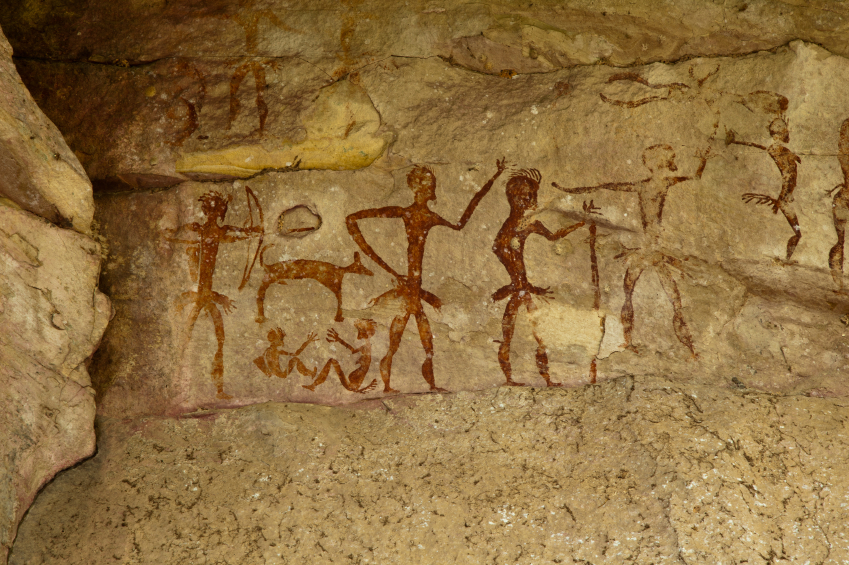

The Paleo Diet is championed by Dr. Loren Cordain, professor of health and exercise science at Colorado State University. Cordain proposes that eating the diet our hunter-gatherer ancestors supposedly ate (humans from the Paleolithic period) – a diet of meat, seafood, fruits, vegetables, and nuts, is healthier than the Standard American Diet, Atkins-style low carb diets, and vegetarian and vegan diets. Paleo is famous for eschewing grains, dairy, and processed food and extolling the benefits of free-range and wild meats. Officially, the suggested nutrient consumption from page 11 of the book is 19- 35% protein, 22-40% carbohydrate, and 28-47% fat, with animal-based foods served at virtually every meal.[1] A major piece of evidence that Cordain uses to support the concept of our ancestors eating such high levels of animal-based foods, protein, and fat is data he extracted from an epidemiological study he conducted of the diets of 229 modern-day hunter-gatherer societies.[2] However, his assumption that these modern-day societies were consuming diets representative of those of humans in the Paleolithic period is a stretch, as demonstrated by researchers who analyzed the geographic conditions associated with the plant-to-animal food ratio of these same modern societies, and concluded their relevance to true Paleolithic diets is dubious given that modern hunter-gatherers live much further from the equator than Paleolithic societies.[3] In addition, evidence as far back as 30,000 does demonstrate that plant-food processing[4] was used by humans, at odds with the Paleo claim that eating grain is an unnatural and recent innovation.
The clear benefit is that Paleo-eaters may be reducing or eliminating sugar and white flour, foods that are associated with rising obesity epidemics.[5] So no arguments there, but what about the rest of the diet?
There is no evidence that we actually need more than the amount of protein recommended by the USDA Dietary Reference Intake of ~0.8g/kg body weight per day.[6] And, as we have seen thanks to Dr. Campbell and others, there is substantial evidence that excess animal protein consumption raises risk for cancer[7] and accelerates cancer progression, while reducing total protein consumption may be able to reverse the cancer process.[8] Simply because humans ate some amount of meat in the past does not mean that eating it now is the best idea. We are fortunate to have so many food options available, and our greatest chances for good health and long life come from a whole food, plant-based diet.
To adequately fulfill nutritional requirements, a diet of 10% protein, 10-15% fat, and 75- 80% carbohydrate can be achieved by eating a whole food, plant-based diet without any special attempt to “get enough” protein or fat. The Paleo Diet promotes an unhealthy excess of protein (especially animal protein), far too few carbohydrates (which our bodies need as their primary energy supply), and a huge amount of fat. Although Dr. Cordain claimed not to promote refined oils in a recent debate with Dr. Campbell,[9] the recipes in his book suggest otherwise. Oil is a processed food just like sugar, so any claim that the Paleo Diet is natural is patently ridiculous, unless Fred Flinstone had an oil factory in his cave. Paleo fans of mayonnaise may be pleased to learn that Brockway Tuna Salad on page 172 of Dr. Cordain’s book contains ½ cup of homemade mayonnaise, which is almost entirely oil. The recipe serves one.
Apparently our ancestors were such talented hunters that they could eat meat or seafood for breakfast, lunch, dinner, and snack, while also pressing oil in their spare time. To check the consistency of Paleo recommendations I tracked the nutrient content of 7 days of Paleo Phase Two (the maintenance level of the diet – what long-term Paleo-eaters are encouraged to follow) using the USDA SuperTracker, which uses data from the USDA Nutrient Database.[11] The meal plans are from pages 152-153, using relevant recipes from the back of the book. It looks like a Paleo-eater, if they splurged on two oatmeal breakfasts and one tofu stir-fry dinner for the three permitted non-Paleo meals, would end up averaging 26% protein, 30% carbohydrate, and 46% fat – intakes every bit as unhealthy as the official Paleo recommendations.[12] The diet would also provide 544 mg of dietary cholesterol per day (of which we need zero).
The Paleo Diet has been rising in popularity, and many claim to feel better eating it, but that is more likely due to the contrast after removing processed food, as opposed to any inherent healthful quality of eating nearly half one’s calories as fat.
Copyright 2025 Center for Nutrition Studies. All rights reserved.